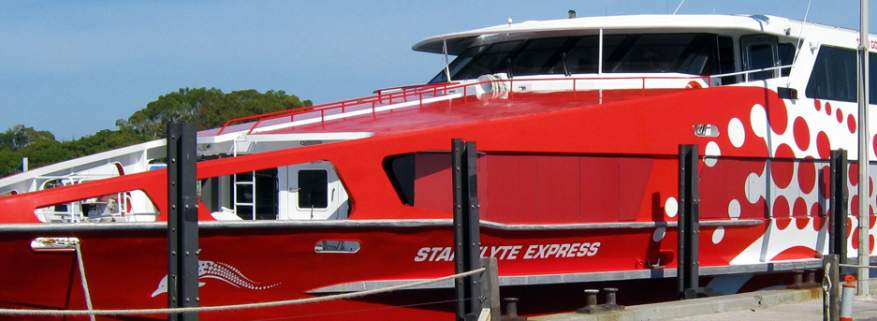Rottnest Island

Rottnest Island is located approximately 18km from Fremantle. It is an A Class nature reserve and is only accessible by water and air transport. Rottnest Island has a casual "Mediterranean" atmosphere. It is a very popular place for state, interstate and international tourists with more than 500,000 people visiting the island each year. It entices tourists with its peaceful surroundings, stunning scenery, fabulous fishing and wonderful swimming spots.
Dutch explorer Willem De Vlamingh landed on Rottnest Island in December 1696. The name Rottnest (originally spelt "Rotte Nest" meaning rat's nest) came about due to De Vlamingh believing that the small marsupials on the island (now known as quokkas) were rats. The first Europeans to take up residency on Rottnest Island was around 1829 when the Swan River Colony was established. In 1881 the Rottnest Island Boy's Reformatory was opened. The Reformatory was a place for young boys to be sent who had come into conflict with the law. It closed in 1901. The island has also been used as an Aboriginal prison in the late 19th century, and an internment camp during World War One until 1917 when it was proclaimed an A Class reserve under the Permanent Reserve Act 1899 and the Rottnest Board of Control was established.
Get The Heritage Trail brochure from the Visitor Centre for detailed histories and map locations.
Vincent Way Heritage Trail
A 2 km walk which takes about 45 minutes. See all the buildings in the Rottnest Island Old Settlement. It starts at the sea wall and includes cottages F and G (built around 1840 by Henry Vincent), cottages H, J and E (built around 1847), the Administrator's Cottage (late 1840s), the boatshed (1859), cottages K1 and K2 (1847), cottage with boatshed (1846), cottage M (1867), cottage L (1871), Buckingham Palace (1871), the Lodge Resort (1880) the Museum (1857), the Quad - an octagonal prison for Aborigines built in 1864, The Chapel (1858), the Ranger's Office (originally the salt store - 1856) and the Hotel (1859) which was converted to a hotel in 1953.
Cape Vlamingh Heritage Trail
A 1 km walk which takes about 30 minutes. See the wreck of the Kiryo Maru, some of the island¹s flora and fauna, the Bridge Rock and the island's Blow Hole.
Oliver Hill Battery Heritage Trail
A 1.5 km walk around the Oliver Hill Battery which was built on the island in 1937. See the fauna and flora of the area as well as the gun emplacements and observation posts.
Vlamingh Memorial Heritage Trail
A 1 km walk from the Lodge to the far end of Garden Lake. See the small cemetery, the quarry where Henry Vincent cut the limestone for his buildings, and the Vlamingh Memorial.
Rottnest Wrecks Heritage Trail
Around the island are the wrecks of the Transit (1842) a wooden two masted schooner, the Gem (1876) a 52 ton British cutter, the Macedon (1883) 562 ton iron steamer, the Janet (1887) a 211 ton 3 masted schooner, the Denton Holme (1890) a 998 ton iron barque, the Uribes (1942) a 188 ton schooner, the Lady Elizabeth (1878), the Raven (1891) a 343 ton 3 masted barque, the Shark (1939), the Anitra (1979) a French yacht which had been sailed from Plymouth - it is now outside the island¹s museum, the Mira Flores (1886) a 500 ton iron barque, the City of York (1899) an 1194 ton iron barque, the Miwok II (1983) an iron barge used for Army Training and the Kiryo Maru I (1984), a Japanese tuna boat which can easily be seen from Cape Vlamingh.
How to get around Island
There are no private vehicles or taxis available on Rottnest Island. The island can be seen by walking, bicycle hire or by bus (timetables available at the Visitor Centre).
Accommodation Types
Rottnest Island Authority: Cottages, Villas, Units, Bungalows, Cabins, Tent Sites, Dormitories, Youth Hostel
Hotel : The Quokka Arms - 08 92925011 - bookings and enquiries
Rottnest Lodge : 08 92925161
Ballot System : Peak School Holidays (summer and easter)
Accomodation is offered through the Rottnest Island Authority via a ballot system during peak school holidays. The ballot system is used to allow everyone who wants to holiday on the island an equal chance of procuring accommodation during the peak periods. July and September school holidays are not subject to the ballot system. To apply for accommodation during the peak periods you must complete a ballot form which can be lodged online or by calling the Customer Contact Centre on 08 94329178.
Luggage Allowances via Ferries
2 bags per booked bed - luggage in excess of this may incur an additional fee and additional delivery time. Surfboards, fishing rods, golf bags etc will not be delivered and it is your responsibility to take to your accommodation. Luggage sizes: maximum of 20 kilograms per bag with handles, maximum of 10 kilograms per cardboard box, no luggage to exceed 1 metre in height, width or depth, and no attaching other items to luggage eg sleeping bags.
Rottnest Island
Latitude:
-32.006195
Longitude:
115.511714
22 May 2021

